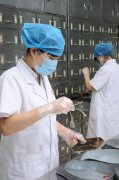Give nephrotic syndrome patient a new life
Before hospitalization,Reem has the symptom of swelling, especially the edema on his feet was so serious that he couldn’t wear his shoes. His family worried him so much and they immediately took him to their local hospital. He had an examination there and the results were as follows: urine routine protein +++, occult blood +++, the red blood cells reached 30 and the deformation rate reached 80%, and what was worse, urine protein in 24 hours reached 6.9 gram. Taking all the indexes into consideration, Reem was diagnosed as nephrotic syndrome.
The results of examination after entering the local hospital were still not optimistic, especially there were still some indexes not normal. Reem’s external symptoms can’t be ignored by his family.
At the beginning of his hospitalization, the most obvious symptom of Reem was edema. Reem came to the hospital even without wearing his shoes and just wrapped with a piece of cloth, because his feet were too edematous to wear his shoes.
Aimed at the pathological feature of nephrotic syndrome and Reem’s physical condition, Jia Jingjing, the doctor-in-charge, made a treatment plan of combining micro Chinese medicine osmosis treatment with blood purification technology immediately and explained to Reem and his parents in detail.
Before he come to our hospital, they had got to many hospitals including provincial hospital, and they had never met that a doctor can make treatment plan like Jia Jingjing. Jia explained the characteristics of nephrotic syndrome beginning with its pathogenesis and why it is recurrent, how we could do to treat and what the principle of treatment is and some specific matters needing attention. All of those made the Reem and his parents surprised.
On February 25, 2014, after half a month treating, the biggest change of Reem is the edema disappeared. The blood and urine routine test results proved to be very satisfied.
The results of examination after entering the local hospital were still not optimistic, especially there were still some indexes not normal. Reem’s external symptoms can’t be ignored by his family.
At the beginning of his hospitalization, the most obvious symptom of Reem was edema. Reem came to the hospital even without wearing his shoes and just wrapped with a piece of cloth, because his feet were too edematous to wear his shoes.
Aimed at the pathological feature of nephrotic syndrome and Reem’s physical condition, Jia Jingjing, the doctor-in-charge, made a treatment plan of combining micro Chinese medicine osmosis treatment with blood purification technology immediately and explained to Reem and his parents in detail.
Before he come to our hospital, they had got to many hospitals including provincial hospital, and they had never met that a doctor can make treatment plan like Jia Jingjing. Jia explained the characteristics of nephrotic syndrome beginning with its pathogenesis and why it is recurrent, how we could do to treat and what the principle of treatment is and some specific matters needing attention. All of those made the Reem and his parents surprised.
On February 25, 2014, after half a month treating, the biggest change of Reem is the edema disappeared. The blood and urine routine test results proved to be very satisfied.




评论
发表评论